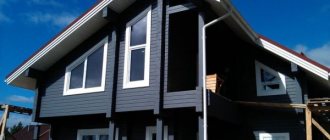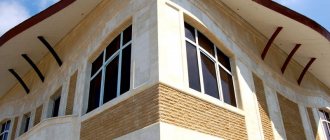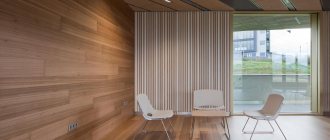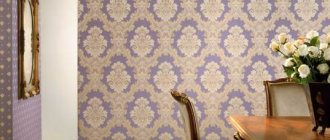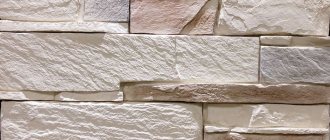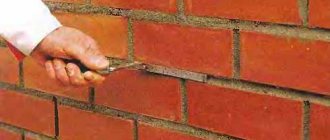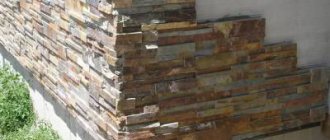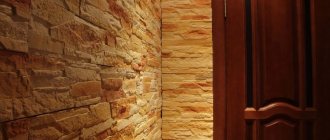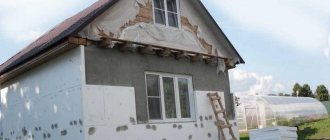Cladding the base with stone: advantages
Stone for the plinth certainly has a lot of advantages:
- Environmentally friendly. This material is not characterized by harmful fumes.
- Long service life. Natural stone for plinth cladding can last for centuries.
- Fire safety. The stones do not burn, and no toxic substances are released during the heating process.
- Moisture resistant.
- High level of decorative properties. Finishing the base with natural stone is always ready to emphasize the status and wealth of the owners.
Types of artificial decorative stone
Clinker
Decorative stone “Clinker brick”
Decorative clinker stone is made in the form of facing bricks or tiles that imitate brickwork. All these products are moisture-resistant, frost-resistant, and can withstand significant temperature changes. Among the advantages of these products is resistance to ultraviolet radiation, due to which the color of the brick or tile does not change under the influence of the sun's rays.
Clinker imitating the texture of a brick surface
All manufacturers of artificial stone produce collections of products that include stones with different surface reliefs and made in different colors. Thus, the same stone, imitating, for example, natural sandstone, will have a different name, depending on the name of the collection.
Clinker tiles with burnt brick look
Artificial granite and marble
Artificial granite and marble are made from a cement-sand mixture with the addition of pigments and polyester resins. This composition has its own name: polymer concrete. Production is carried out in accordance with TU 4940-001-00284581-2002.
Polymer granite
Artificial decorative stones are highly durable and outwardly indistinguishable from their natural counterparts. Artificial granite and marble have a significant weight, so all manufacturers strive to make the slabs as thin as possible, but without compromising the technical characteristics of their products.
Characteristics of artificial marble
| Material | Density (kg/m3) | Compressive Strength(MPa) | Flexural strength (MPa) | Impact resistance (J) | Water absorption (%) |
| Artificial marble | 1500-2200 | 70 or more | 14 or more | 0,06 | Less than 1% |
Particularly popular is a type of artificial granite called porcelain stoneware. It is made from a mixture consisting of several types of clay, dyes and mineral additives. The surface of the plates can be glossy, matte, or embossed.
Porcelain tiles for facade
House facade made of porcelain stoneware
All products have the correct geometric shape and are easy to install
But experts draw the consumer’s attention to the fact that porcelain stoneware is quite difficult to process due to its relatively low impact resistance. In this regard, trimming slabs can cause chips and cracks.
Slabs made of artificial marble and granite are suitable for cladding walls, plinths, entrance lobbies, architectural elements of a building, window and door openings. These artificial stones can be used to pave paths and make a blind area around the house. From multi-colored fragments of marble, mosaics are laid out on the walls of the house, and spectacular panels and paintings are created.
The use of marble and granite in cladding guarantees an excellent aesthetic effect, protection of walls from dampness, and high-quality thermal insulation. These artificial stones are suitable for cladding buildings built in any architectural style. Marble and granite give the building a solemn and strict appearance, adding an accent of solidity and well-being.
Marble facade cladding
Granite plinth finishing
The technology for producing cast artificial marble and granite is almost no different from the technology for producing paving slabs. The main difference lies in the components used to prepare the molding sand and their percentages.
Agglomerates
Agglomerates (or quartz agglomerates) are artificial decorative stones, for the production of which a mixture of quartz sand, dyes, a binder and chips of natural stones (mainly marble and crushed stone) is used. Agglomerates in their technical characteristics are closest to natural stone. The reason is the small amount of polymers that make up quartz agglomerates and the significant content of natural components.
Quartz agglomerates
Artificial stones of this type are made by vibration pressing. Depending on the fraction of stone chips and other raw materials, the surface of products can have a very different texture. Agglomerates can imitate the appearance of any natural stone. A distinctive feature of these products is their low abrasion and high strength provided by the quartz included in the composition.
Quartz agglomerate beige
Types of material
Here are the most popular finishing options:
- Facing the base with wild stone - slate or quartzite. Due to their dense structure, these materials are resistant to destructive factors. The color palette of stones is quite rich. Light and dark shades are often complemented by spectacular veining. Slate slabs are sometimes combined with another type of finish. However, it must be taken into account that the climatic conditions of the area of origin of the rocks must be similar.
- Finishing with shell rock is a budget option. The range of shades here is not great. Only yellow colors are available. And the porous structure of the stone requires special protective treatment.
- Sandstone slab is also an inexpensive material. However, in terms of its strength characteristics, it is much inferior to other natural stones.
- Granite slabs are definitely a premium segment. The high level of decorative properties and excellent performance characteristics allow us to give this material the highest ratings. It copes well with the load caused by temperature changes and high humidity.
- Experienced craftsmen can skillfully imitate stone for a plinth using a cheaper option - concrete. Of course, such cladding will be significantly inferior to natural materials in terms of quality and service life. However, this option will give the house an expensive look while saving a lot of money.
Pros and cons of natural stone when finishing facades
First of all, it is worth noting several features that distinguish stone from other materials:
It is produced by nature itself. Even during the processing process, it is not treated with chemicals in order to act on it as naturally as possible. Therefore, we can say with complete confidence that this is an environmentally friendly product, safe for humans and the environment.
Interesting! Some claim that there are types of stone that are radioactive. But this is just a trick of those who offer artificial analogues.
- It has a unique texture and texture. Thanks to this, each building is unique.
- Durable. The stone does not collapse for centuries. At the same time, it is resistant to environmental influences (it is not afraid of cold, heat, snow, wind, sun rays). And the risk that the stone cladding will burn out after some time is simply excluded.
- It has unique properties, thanks to which stone cladding will keep the inside of the house cool in summer, and, on the contrary, warm in winter. Accordingly, the house will always have an optimal microclimate.
- Vapor permeability. This is a breathable material. Vapor permeability indicators may vary depending on the specific breed. Shell rock and sandstone are considered the most vapor-permeable.
- Easy to install. Since stone slabs are quite thick and durable, they can be safely installed even if there are many uneven surfaces.
- Appearance. No words needed here. No artificial material will look so chic and rich.
Are there any downsides?
These usually include the high weight of the material. Cutting it yourself is not so easy. But even if you purchase ready-made material, it can only be laid on durable surfaces that can withstand high loads. The best option would be concrete or brick. But wooden houses and buildings made of cellular concrete are not suitable for such an impressive finish.
Healthy! In fairness, it is worth noting that not every breed is distinguished by high weight. You can also find lighter options.
Another significant disadvantage of the stone is its cost. For example, if you want to finish it with marble or granite, then you need to be prepared for the fact that 1 m2 will cost about 1,500 rubles (and this is not the highest cost limit). But you can always find a more affordable option. For example, sandstone will cost 250 rubles per square meter. Therefore, it all depends on what material you choose.
DIY cladding
You can decorate with natural stone yourself. First of all, you need to choose the right solution. It is important to pay attention to the characteristics of the breed used:
- Moisture-resistant quartzite and dark granite slabs can be laid using any adhesives or mortars.
- If we are talking about light granite, sandstone or dark marble, then the solution can only be used in areas with a warm climate. In areas where frost occurs, the choice is made in favor of glue.
- White marble or granite slabs, limestone or travertine are laid exclusively using special glue. The use of sand-cement mortar in this case is prohibited.
Step-by-step instruction
- First you need to prepare the foundation surface. The surface must be flat. The seams are rubbed, the sagging is lost. Then everything is coated with primer twice.
- Selecting natural stone slabs for finishing the foundation is an important step. When purchasing, be sure to evaluate the thickness of the tiles. According to the recommendations of experts, it is better if it does not exceed 3 cm.
- Sort the tiles by size. And then start laying them out on the ground in the order in which they will be glued to the foundation.
- Start laying from the bottom row, securing the slabs not only with glue, but also with anchor bolts. This will help avoid subsidence of the finish.
- Lay out the largest pieces of stone first. Then fill the remaining voids with smaller elements. Remember to leave gaps between the stones.
- After installation is completed and the glue has dried, the joints are grouted. The grout mixture is selected based on the shade of the stone.
- In some cases, the stone is finally coated with façade waterproof varnish. It is recommended to do this at least four days after installation is completed.
Instructions for finishing facades
Facade cladding consists of several stages of work. The main steps are surface preparation and stone laying. First of all, after drawing the facade, the amount of material required is calculated. To do this, the total area of the cladding and the number of necessary elements with a small margin are determined.
The next step is surface preparation. It should be smooth, covered with new plaster. The stone is laid on a moistened surface. The part is covered from the inside with a special solution and pressed against the wall, the excess solution is carefully removed.
After completing the cladding, it is necessary to fill the joints with a special solution. The seams are filled with it through the cut off corner of an ordinary plastic bag. After it hardens, the seams are smoothed with a spatula, and excess mortar is removed with a wet rag.
Cladding work cannot be carried out in frosty conditions or at low temperatures. In addition to the classic installation of stone on a plastered surface, technologies for attaching stone to a metal frame are used to produce so-called ventilated facades. This technology is more complex compared to the classical method.
The cladding process requires strict adherence to technology. If it changes, significant financial losses are possible. You can also finish the façade yourself; it will cost less. If all stages are completed correctly, the building will be transformed, acquire its own uniqueness, and will stand out with its beauty against the background of neighboring buildings.
Additional protection for stone cladding
Facing the foundation with base stone looks very impressive. However, it should be kept in mind that it requires special care.
To clean and preserve natural qualities and color, it is recommended to use specialized soap.
To prevent the porous surface of natural stone from becoming clogged with dust, it is covered with a transparent protective acrylic film, which also performs a water-repellent function. This coating retains less dirt and allows natural stone to retain its attractive appearance longer.
Types of masonry
The masonry should be selected based on the style of the house and site.
Types of masonry:
- Caste is an approximation to the masonry that was used in the Middle Ages.
- Plateau is a figured masonry method. Rectangular or square stones with processed edges are used.
- Shahriar - all stones are rectangular in shape, with a border around the edges.
- Rondo - pebbles of different sizes serve as the facing material.
- Assol - thin rectangular plates made of natural or artificial material.
There are other types of masonry, for example, brick, where clay or hollow bricks are used. Brick with cladding involves the use of both natural and artificial stones of different sizes. The small-block variety uses exclusively porous materials that are laid by hand, for example, porous tuff.
Rubble concrete masonry involves laying irregularly shaped stones, possibly fragments, together with a concrete mixture. Rubble masonry is carried out using stones that are of natural origin, with an irregular shape and a size of no more than 50 cm. Timber masonry is the opposite of the previous one; in this case, natural stones undergo special processing and are laid by hand or using machinery.
Materials of natural origin are more popular, although their cost may not differ significantly from artificial material.
Dimensions and weight
The weight of the facade panel depends on its size and material of manufacture. The size is determined by the ease of installation and transportation. Lightweight plastic plates weigh approximately 1.8-2.2 kg. The size of the panels is developed by the manufacturer. Depending on the type of stones being simulated, the length and width parameters vary. The length can vary from 80 cm to 130 cm. The width varies from 45 to 60 cm. On average, the area of one panel occupies half a square meter. The thickness is small - only 1-2 mm.
Fiber cement boards for facades are large in size and heavy in weight. Length from 1.5 to 3 m, width from 45 to 120 cm. The smallest thickness of the panel is 6 mm, the maximum is 2 cm. The weight of products made of heavy cement can vary depending on the thickness of 13 - 20 kg per square meter. On average, fiber cement boards weigh 22 – 40 kg. One large thick panel can reach a weight of more than 100 kg.
Features of extraction and processing
To obtain material in a quarry, rock is destroyed with explosives. For smaller jobs, a jackhammer is used. After this, the stones are ungrouped. Larger ones, the thickness of which is more than 10 cm, are used as rubble stone. This option is perfect for a foundation. More even pieces, the thickness of which is in the range of 1-10 cm, are carefully sorted. They are precisely called “wild stone”. These materials are further split to form plates.
Of course, such plates have an uneven surface, which makes the stone not particularly convenient for arranging paths. The exception is recreation areas and artificially made clearings.
Products that have undergone mechanical processing are also available for sale. For example, stone can be ground, milled, sawed, etc. The result is products of different shapes and textures:
- Rock. This type of stone is practically not processed, maintaining its natural appearance.
- Bush hammer. The surface on which pinholes are created, as if from impacts.
- Polished. It has a more even texture. But traces of mechanical processing are intentionally preserved.
- Sawn. The stone has its own natural roughness. Flame is often used in the processing process.
- Polished. It has a matte, almost smooth surface.
- Polished. Processing is carried out until a mirror shine appears on the surface.
Finish selection criteria
The decor of the living room must be chosen correctly, otherwise the desired effect will not be achieved.
A successful combination of stone texture with other materials. The surface of natural or synthetic cladding must be in harmony, first of all, with the texture of other walls, floors and ceilings. But the texture of the carpentry (windows, doors, slopes, baseboards), furniture and accessories also need to be carefully selected to match the interior with stone. Shade of decorative stone. In a thoughtful design, no color should fall out of the overall solution. Classic - 3 primary colors, 2 auxiliary colors (contrasts or variations of shades) and 1 emotional accent. If there is masonry in the interior of a living room, this principle cannot be ignored. The shade of the stone should match the choice of the main background or form a good contrast with other finishes. Size and shape. All finishing parameters must be subordinated to the general idea. If something creates disharmony, the overall impression will be ruined. This is precisely the reason for luxurious designer apartments and not very good solutions. For some cases, rectangular components of decorative finishing are suitable, for others - square stone-like facing tiles “without seams”. The modern market is replete with offers, so there is no need to rush into experiments. Try to review several catalogs with artificial stone, then use your imagination by imagining the selected option in your room. Well placed accents. Experts do not recommend using artificial stone in the interior of an apartment as the main background of the walls, with the exception of the hallway or toilet. In other rooms, it is better to make a decorative panel, an arch for zoning, columns or veneer a fireplace. If the interior does not have brighter elements, the main attention will be directed to stone decor
2-3 elements with the same facing material in a calm shade look good. The quality of the masonry. No matter how attractive the stone on the wall in the interior may be, the quality of the cladding is important. If the design concept requires this, the masonry can be careless, but in most cases it is assumed to work at a level and plumb. Quality artificial stone.
The walls in the living room can be decorated with decorative stone
The walls in the corridor can be decorated with decorative stone
A decorative chocolate-colored stone will look great in the living room interior
Many manufacturers care about their reputation by offering high-quality decorative stone for finishing residential premises. If the technology has not been violated, then the finished material will have excellent aesthetic qualities. Toxic substances should not be used as binders and coloring components. It is worth asking who produces the product and how safe the components are. Cheap facing materials lose color and crumble over time.
If the technology was followed during production, then a wall made of a synthetic analogue should have less weight than one made from a natural one, but perfectly imitate the texture. In addition, the smooth back side of the decorative agglomerate is easier to install and more durable to use. This is not only an excellent decor, but also the best way to cover a wall or corner with defects - fungus, rust stains, cracks and pits.
White decorative stone will perfectly complement the interior of the room
Wall decoration in the bedroom can be done with decorative stone
Prices for facade cladding in Moscow
Pricing for façade cladding by construction organizations should be based on ENiR standards (Unified Norms and Prices), multiplied by the coefficient in effect at the time of work. In reality, prices for construction work in different organizations can vary significantly. The price for work may be influenced by the following factors:
- volume, timing and location of work;
- the condition of the walls for cladding and the degree of complexity of the preparatory work;
- type, type and even price of finishing material.
If we talk about the current average price for performing facade work, then we can settle on the following approximate amounts for 1 sq.m of cladding:
- working with natural stone to finish facades and plinths will cost the customer 2,000 rubles per m²;
- the same work, but with artificial stone blocks - 1400 rubles/m².
Don't forget about additional work. For example, hydrophobization of a façade stone surface will cost approximately 75 rubles per m².
Even wooden houses can be finished with stone - an example in the video:
Stone laying process technology
Regardless of the type of stones used, the basic requirements for laying them on the facade should be taken into account:
- A natural material with a voluminous texture has more weight than polished granite, marble or sandstone. A cement-sand mortar is used, and the masonry joints are filled with sealant.
- For small sizes and low weight of tiles, additional fasteners are not used.
- Gaps are left between the pieces and slabs of stone.
- It is better to lay material with a dark color on the base.
The cladding process begins with surface preparation. This is followed by the direct laying of natural stone and cladding of windows, doors and cornices.
Facade preparation
This is the first stage in finishing the facade with natural stone. The work is not difficult, the main thing is to clean the entire surface from dust and dirt. The preparatory process depends on the material of the walls of the house.
If brick was used and the surface turned out to be slightly ribbed, no additional work is required. In the case of a smooth wall surface, be sure to nail a metal mesh. This applies to smooth brick, foam block, gas silicate block and similar building materials. Plastered walls should be cleaned of dirt and dust.
Figure 7. Facade surface preparation.
Joining seams
In order for the façade cladding to be done efficiently, the seams between the stones should be properly embroidered. It is this operation that gives the masonry an aesthetic and finished look.
When working with stone, several types of jointing are used:
- concave - for masonry with rough fitting of stones;
- double-cut convex - when using flat pebbles;
- super convex - when working with flat slabs and their poor fit.
After jointing has been completed and the mortar has completely dried, the stonework is washed well with a soapy water solution. In this case, the remaining grout is removed, and the facade takes on a finished, attractive appearance.
Installing the mesh and securing it
The use of mesh when cladding the facade creates better adhesion of the material to the prepared surface. They fasten it with dowels at the rate of 10 pieces per 1 sq. m.
It is better to use galvanized welded metal mesh with increased corrosion resistance. It will be a good basis for adhesion of the solution or glue to the material.
Laying slabs
Work on laying decorative and artificial stone is carried out in the following sequence. After fixing the grid, mark the starting level. It will serve as the basis for the first row. First, lay stones on the corners and stretch a thread between them. The first row is laid out on it.
Each stone is separately coated with mortar or glue. The wall before facing is also coated with the mixture.
It is advisable to lay the first few rows along the thread, and then use a building level. During work, the angle of inclination of the stones is periodically checked using a plumb line.
Cladding of windows and cornices
When lining window and door openings, interfloor cornices, fishing line must be used. It is better to use small and short fragments of masonry. Since long geometric structures require perfect precision of work. Pieces of stone should be laid out evenly so that wall defects are not noticeable.
The material for edging windows and cornices is selected depending on the overall design style of the house. The work uses cornices, stone slopes, stone window sills, and platbands.
Specifics of installation of facade natural stone
Work begins with the preparatory stage: builders prepare the required type of mortar and begin to perform the main tasks:
- Definition of zero level;
- Fastening slabs to the corners of walls;
- Then the level is beaten off or the corners for the first row are connected;
- Applying the solution to the material and work surface;
- Pressing the material, removing excess mixture;
- Carrying out masonry level control;
- The stone is pressed, excess mixture is removed;
- Cladding of cornices and slopes.
It is better to entrust the finishing of the facade with natural stone to professional specialists who will correctly make calculations and carry out the installation correctly. Typically, the cost of finishing services is calculated in m2.
Types of stone-look facade panels
Let's look at the most popular options that help create an interesting visualization of masonry, incl. such textures as wild stone, rock, slate.
PVC or vinyl
They are based on various polymers, to which coloring, modifying and stabilizing substances are added, resulting in options of a wide variety of colors and textures.
Possible options for PVC panels
Advantages of plastic panels:
- fireproof;
- water resistant;
- Fade resistant;
- have little weight;
- easy to install and maintain;
- inexpensive.
Weaknesses of the material:
- release toxic gases in case of fire;
- become brittle in the cold.
Fiber cement panels
They are made from sand and cement with the addition of cellulose and mineral fiber as follows: cement mortar is poured onto a reinforcing frame made of cellulose, synthetics or fiberglass, and the outside of the slab is coated with acrylic. Due to the high cement content, the panel is quite hard. Some manufacturers add mica and quartz sand, which increases the strength and durability of the products. And in order for them to be resistant to ultraviolet radiation and precipitation, a varnish coating is applied to them. Also, the use of high-quality dyes and varnishes creates unique textures and colors of surfaces.
Video - Japanese fiber cement panels
Table 1. Main manufacturing companies of fiber cement panels.
| Company name | Peculiarities | Panel price/rub. |
| Kmew | A Japanese brand whose slabs are characterized by increased frost resistance due to the presence of special microgranules in the composition. | from 1500 |
| Zierer | The German company has been producing safe, durable panels for more than 30 years, which retain their original appearance for many years. | from 1000 |
| Casa Verde | The Russian company has been producing panels and thermal panels since 2012, the warranty service life is 30 years, and the estimated service life is 100 years. | from 1000 |
| TechnoNIKOL Hauberk | The Russian manufacturer has been producing panels with an outer layer of natural basalt for more than two decades, which ensures a long service life. | from 500 |
Appearance of fiber cement panels
Advantages:
- strength is the main advantage, which corresponds to the quality of porcelain facade tiles;
- fire resistance;
- resistance to low temperatures and changes allows it to be used even in harsh climate conditions;
- equipped with ventilation slots, thereby allowing air to circulate freely between the panel and the heat-insulating layer;
- has a heat-insulating and sound-absorbing function;
- can be used both outside and inside the building;
- no preparation is required before finishing.
Flaws:
- not very presentable appearance, as a result of which the panels require painting after installation;
- high price.
Stone-look facade panels
Insulated panels
They are based on insulation, and the front side is a designer layer of polymer coating, consisting of polyvinyl chloride, resin, foam and stone dust, which allows you to clearly highlight the stone texture, emphasize slate rock, rubble and wild stone.
Schematic composition of an insulated panel
Advantages:
- do not exert strong pressure on the foundation;
- the finishing process can be carried out in any climatic conditions;
- quick payback, due to the fact that a house covered with panels can be heated at half the cost;
- fireproof;
- do not allow mold and fungi to multiply;
- very durable.
Flaws:
- thorough surface preparation is required;
- high price.
Stone or brick effect tiles, ceramic and clinker
This type includes thermal panels; they are a clinker facing material with polyurethane foam. The tiles are made from clay with a mineral composition. Fireclay is added to clay for heat resistance.
General view of the panel
Advantages:
- safe for the environment;
- moisture resistant;
- easily tolerates temperature changes;
- service life is several decades;
- great thermal insulation;
- not fussy to care for;
- easy to repair;
- due to its low weight, it does not put a load on the foundation;
- not afraid of exposure to ultraviolet rays.
Weak sides:
- high price;
- fragility of the decorative layer, and in some cases, the insulation.
